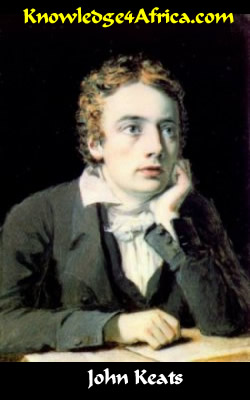|
READ THIS
"To Autumn" is regarded as Keats's best poem, written with graphic clarity just before his death.
He personifies the season, dressed in its rich autumn colours and alive with life and mellow vibrancy.
Everything is maturing now.
The fruits on the trees are at their sweetest, the wine is oozing with heady tranquillity. Everywhere the
birds and the insects are enriching the countryside with their melody.
 ABOUT THE POET
ABOUT THE POET
John Keats was born in London in 1795, the son of a hostler. Both his parents died while he was still
young -- his mother of tuberculosis. He was thereafter brought up by his grandmother who quickly made
him an apprentice physician.
He was still only in his late teens when he discovered that he too had caught TB and his younger brother
who was in his care soon died of it. In order to escape the disease, Keats moved to the sunnier and drier
climate of Italy.
There was no escape for him, however, and the poet died in 1821. He was then just 25 years of age. He
nevertheless bequeathed us a gargantuan amount of poetry written with an amazing maturity for one so
young.
Keats wrote this Ode one autumn evening in 1819. It has been said that he could not focus on his writing
because somebody nearby was disturbing his thoughts by practising on the violin. The poet went out for
a walk and, inspired by the autumn atmosphere, returned to write this poem.
Have you looked at the questions
in the right column?
|
TEST YOURSELF!
Read the left column and then answer
the following questions:
"SEASON of mists and mellow fruitfulness,
Close bosom-friend of the maturing sun."
- What is a "bosom-friend"? (2)

[Need help?]
A "bosom-friend" is a very close friend or an intimate acquaintance. "Bosom" is another
word for "breasts" and so a "bosom-friend" is one who is so close as to be allowed near
one's breasts -- almost a lover.
|
- What is the effect of the alliterated "m" in "mists and mellow"? (2)

[Need help?]
The "m" creates a gentle humming sounds and creates a drowsy tone. The poet uses this
alliteration to portray the gentle sleepiness of the moment, when there are mists and the world is gentle
and laid back.
|
"Conspiring with him how to load and bless
With fruit the vines that round the thatch-eaves run."
- Is the term "load and bless" a prayer? If so, who is praying to whom? (4)

[Need help?]
It is not so much a prayer as it is some goddess and her god -- i.e. Autumn and the Sun -- who are
seeking to pour blessings upon the harvest.
A "blessing" is the bestowing of a spiritual gift which produces good as opposed to a curse
which produces evil.
It is the blessing of life: the vines are vibrant and full of life. They have conceived and bear fruit just
like a pregnant woman -- and are now growing plump as the fruit reaches sweet maturity.
|
"To bend with apples the moss'd cottage-trees,
And fill all fruit with ripeness to the core;
To swell the gourd, and plump the hazel shells
With a sweet kernel."
- What does the description of the "moss'd cottage-trees" tell you about the general climate of
the region? (2)

[Need help?]
The "moss'd cottage-trees" tells us that the region is damp for long periods at a time -- probably
during winter. Moss grows in damp conditions and so, even though it is now summer with its sunshine
and warmth, the moss remains clinging to the trees.
|
- The poet conjures up in these four lines a feeling of success and prosperity. How does he do it? What
words in particular enrich this concept? (4)

[Need help?]
Note the image of plumpness, prosperity and sweetness.
The fruit is ripe with maturity, having successfully achieved its purpose in life. No part of it is not ripe:
"ripeness to the core".
The gourds and hazel nuts are swelling and becoming plump with the richness of life, like a pregnant
woman swells and becomes plump until the final miracle of birth.
Plumpness also conjures an image of success. It was once believed that a plump person was a
successful person, one who could eat well and would therefore be healthy. To be "fat" was
therefore synonymous with "health".
Everything is sweet and delicious. Sweetness was the image of ultimate maturity. Hence the expression,
"She is such a sweet person."
|
"to set budding more,
And still more, later flowers for the bees,
Until they think warm days will never cease;
For Summer has o'erbrimm'd their clammy cells."
- Who is being referred to when the poet speaks of "they" who think the warm days will never
cease? (2)

[Need help?]
It is the bees who think the warm days will never cease.
|
- What are the "clammy cells" that have been "o'erbrimm'd"? (2)

[Need help?]
The "clammy cells" are the honey-combs: little hexagonal cells filled with honey -- in fact, so full
that the honey is overflowing.
|
- What is the purpose of parenthesis? Identify an example of parenthesis in the above
quotation. (4)

[Need help?]
Parenthesis is the addition of extra information which is not necessarily part of the sentence. It
is usually found inside brackets, dashes or commas.
In the quotation above, the words "And still more" are a parenthesis: three words which add
meaning but are not essential to the overall understanding and are contained within commas.
|
The poet often uses inverse word order. Restructure the following quotes so that their meaning becomes
more clear:
- "How to load and bless with fruit the vines"; (2)

[Need help?]
"How to load and bless the vines with fruit."
|
- "To bend with apples the moss'd cottage-trees"; (2)

[Need help?]
"To bend the moss'd cottage-trees with apples."
|
|



